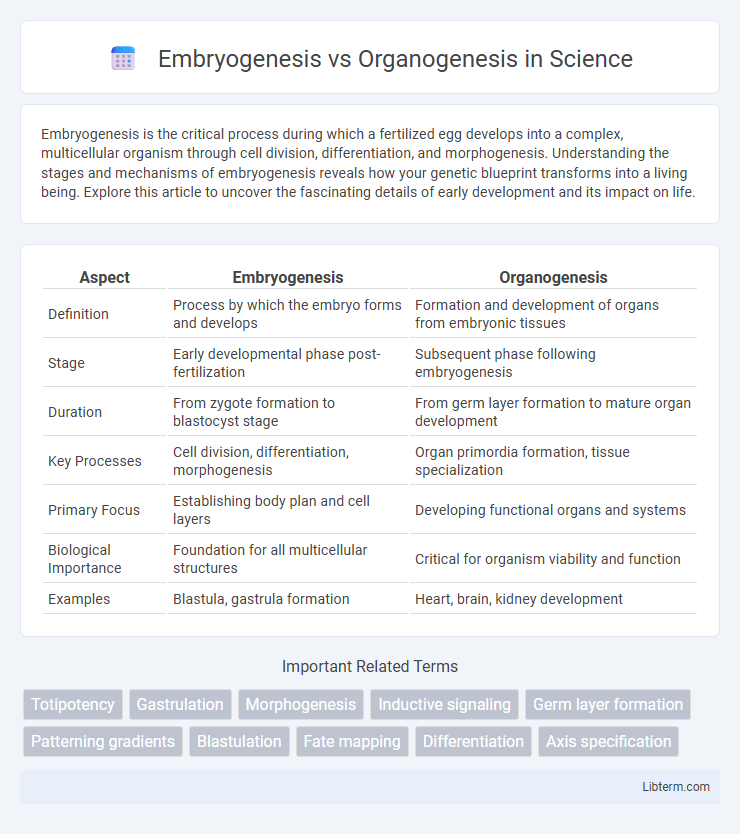Embryogenesis is the critical process during which a fertilized egg develops into a complex, multicellular organism through cell division, differentiation, and morphogenesis. Understanding the stages and mechanisms of embryogenesis reveals how your genetic blueprint transforms into a living being. Explore this article to uncover the fascinating details of early development and its impact on life.
Table of Comparison
| Aspect | Embryogenesis | Organogenesis |
|---|---|---|
| Definition | Process by which the embryo forms and develops | Formation and development of organs from embryonic tissues |
| Stage | Early developmental phase post-fertilization | Subsequent phase following embryogenesis |
| Duration | From zygote formation to blastocyst stage | From germ layer formation to mature organ development |
| Key Processes | Cell division, differentiation, morphogenesis | Organ primordia formation, tissue specialization |
| Primary Focus | Establishing body plan and cell layers | Developing functional organs and systems |
| Biological Importance | Foundation for all multicellular structures | Critical for organism viability and function |
| Examples | Blastula, gastrula formation | Heart, brain, kidney development |
Introduction to Embryogenesis and Organogenesis
Embryogenesis refers to the early stages of development where a fertilized egg undergoes rapid cell division, differentiation, and formation of the basic body plan. Organogenesis follows embryogenesis and involves the development and specialization of organs from the primary germ layers established during early embryo formation. These processes are fundamental in shaping the anatomical structure and functional systems of multicellular organisms.
Defining Embryogenesis: Early Developmental Stages
Embryogenesis encompasses the initial stages of development where the fertilized egg undergoes cleavage, forming a blastula and subsequently a gastrula, establishing the three primary germ layers: ectoderm, mesoderm, and endoderm. These germ layers serve as the foundational tissues from which all organs and systems will derive during organogenesis. Defining embryogenesis highlights its role in setting the structural and cellular groundwork essential for the subsequent organ formation processes in multicellular organisms.
Understanding Organogenesis: Formation of Body Organs
Organogenesis refers to the critical phase of embryonic development where distinct body organs form from the three primary germ layers: ectoderm, mesoderm, and endoderm. This process involves cellular differentiation, morphogenesis, and growth, transforming simple embryonic tissues into complex structures such as the heart, lungs, liver, and brain. Understanding organogenesis provides insight into developmental biology, congenital anomalies, and regenerative medicine.
Key Differences Between Embryogenesis and Organogenesis
Embryogenesis is the early developmental phase where a single fertilized egg divides and forms the basic body plan, while organogenesis is the subsequent stage where specific organs and tissues develop from the embryonic germ layers. Embryogenesis includes processes like cleavage, blastulation, and gastrulation, whereas organogenesis involves differentiation and morphogenesis of organs like the heart, liver, and brain. The key difference lies in embryogenesis establishing the foundational embryo structure, whereas organogenesis shapes functional organs critical for viability.
Molecular Mechanisms in Embryogenesis
Embryogenesis involves intricate molecular mechanisms such as the regulation of gene expression through transcription factors like Oct4, Sox2, and Nanog, which maintain pluripotency and guide cell differentiation. Signal transduction pathways including Wnt, Hedgehog, and BMP coordinate cell fate decisions and spatial organization during early embryonic development. These molecular events establish the foundational blueprint that precedes organogenesis, where more specialized structures and organs form.
Genetic Regulation During Organogenesis
Genetic regulation during organogenesis involves complex interactions between transcription factors, signaling pathways, and gene expression patterns that guide the differentiation and morphogenesis of organs from embryonic tissues. Key regulatory genes such as HOX, PAX, and SOX families orchestrate spatial and temporal gene activation, ensuring proper organ formation and tissue specialization. Epigenetic modifications and feedback loops further refine these genetic networks, enabling precise control over cellular proliferation, migration, and organ-specific function development.
Cellular Processes Involved in Both Stages
Embryogenesis involves cellular processes such as fertilization, cleavage, blastulation, and gastrulation, which establish the primary germ layers through cell division, differentiation, and morphogenetic movements. Organogenesis follows, characterized by the specialization, proliferation, and spatial arrangement of cells from the germ layers into specific organs, driven by signaling pathways and gene regulatory networks. Both stages require coordinated cellular communication, adhesion, and migration to ensure proper tissue patterning and functional development.
Evolutionary Perspectives: Embryogenesis vs Organogenesis
Embryogenesis and organogenesis represent crucial stages in developmental biology, with evolutionary perspectives highlighting the conservation and divergence of genetic regulatory networks across species. Embryogenesis involves the early formation of the body plan and germ layers, showcasing evolutionary adaptations in morphogenetic processes that ensure species-specific developmental trajectories. Organogenesis, following embryogenesis, reflects evolutionary innovations in organ complexity and function, driven by gene duplication and specialization events that contribute to organismal diversity and adaptation.
Clinical Significance and Congenital Disorders
Embryogenesis establishes the basic body plan and primary germ layers, making disruptions critical for early miscarriage or severe malformations. Organogenesis, involving the differentiation of these layers into organs, is highly sensitive to teratogens that can cause congenital disorders such as heart defects, neural tube defects, and cleft palate. Understanding the timing and molecular mechanisms of both processes aids in prenatal diagnosis, genetic counseling, and developing preventive interventions for congenital abnormalities.
Future Directions in Developmental Biology Research
Future directions in developmental biology research emphasize advanced imaging techniques and gene editing technologies like CRISPR to unravel the precise molecular mechanisms governing embryogenesis and organogenesis. Single-cell RNA sequencing and spatial transcriptomics are being employed to map cellular differentiation pathways with unprecedented resolution, facilitating targeted therapeutic interventions for congenital anomalies. Integrating computational modeling with experimental data accelerates predictive understanding of tissue morphogenesis and regenerative medicine applications.
Embryogenesis Infographic

 libterm.com
libterm.com